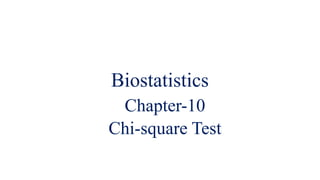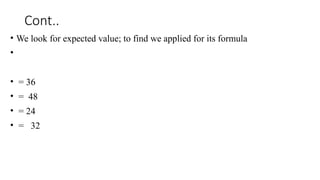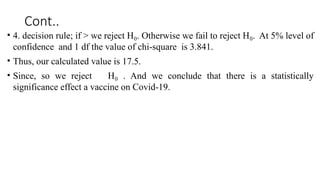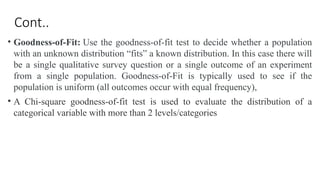Biostatistics- lesson is chapter-10.pptx
- 2. Lecture Objective • To understand the concept of Chi-square test • To learn about two main types of Chi-square test • Chi-square for independence test • Chi-square for Goodness of fit test • To determine uses of two main types of chi-square test. • To recognize contingency table and its appropriate for Chi-square independence test • To learn about formula in Chi-square test
- 3. Introduction to Chi-square • Definition • Chi-squared test is a statistical test used to find the relationship between the observed values and the expected values of raw variables. • The chi-square test is a non-parametric test that compares two or more variables from randomly selected data. • A chi-square test is a statistical test that can figure out; • if there is any statistical significance between categorical variables. • It is used to determine if results are due to chance or due to some relationship between the studied variables. • To determine whether the association between two qualitative variables is statistically significant, researchers must conduct a test of significance called the Chi-Square Test.
- 4. Assumptions • Assumptions 1.One categorical variable - can be dichotomous, nominal, or ordinal 2.Independence of observations 3.Groups are mutually exclusive - participants can only belong to one group 4.At least 5 expected frequencies in each group
- 5. Uses of the Chi-Squared test Statistic • The purpose of chi-square test is; • To compare for categorical data. • The chi-squared statistic provides a test of the association between two or more groups, populations, • The chi-square test can be used to test the strength of the association between exposure and disease in a cohort study, an unmatched case-control study, or a cross- sectional study. • To determine if the observed experimental variables are independent each other by calculating their statistical significance. • If statistical significance is present, the null hypothesis is rejecting. • If statistical significance is absent, the null hypothesis fail to reject.
- 6. Types of chi-square test • Pearson's chi-square tests are classified into two types: 1.Chi-square of independence test 2.Chi-square goodness-of-fit test • Mathematically, these are actually the same test formula. • However, we often think of them as different tests because they’re used for different purposes.
- 7. Chi-square test of independence • Definition: • A Chi-Square Test of Independence is used to determine whether or not there is a statistically significant association between two categorical variables( Qualitative variables). • This test is used when we have two categorical variables (nominal or ordinal) • When to use the chi-square test of independence • The chi-square test of independence is used to when we have two categorical variables and you want to test a hypothesis about their relationship. • In this case there will be two qualitative survey questions or experiments and a contingency table will be constructed.
- 8. Formula for Chi-square Test • The chi-square formula • Both of Pearson’s chi-square tests use the same formula to calculate the test statistic, chi-square (Χ2): • Where: • Χ2 is the chi-square test statistic • Σ is the summation operator (it means “take the sum of”) • O is the observed frequency • E is the expected frequency
- 9. Tests Using Contingency Tables • Contingency tables • When you want to perform a chi-square test of independence, the best way to organize your data is a type of frequency distribution table called a contingency table. • A contingency table, also known as a cross tabulation or crosstab, shows the number of observations in each combination of groups. • The goal of the contingency table that will be constructed is to see if the two variables are unrelated (independent) or related (dependent). • It also usually includes row total and column totals.
- 10. Real-life examples in chi-square for independence • A Test about the Covid-19 vaccine preventive the following result found; • Solution Attacked Not- Attacked Vaccinated 24 60 Not- vaccinated 36 20 Attacked Not- Attacked Total Vaccinated 24 60 84 Not- vaccinated 36 20 56 Total 60 80 140
- 11. Cont.. • We look for expected value; to find we applied for its formula • • = 36 • = 48 • = 24 • = 32
- 12. Cont.. • The solution will be follow five steps procedure hypothesis • 1. H : there is no effect a vaccine on Covid-19 ₀ • H : there is effect a vaccine on Covid-19 ₁ • 2. 0.05 • 3. = + + + = 17.5 • Degrees of freedom = 1 for a 2x2 table • Df = (r- 1)(c – 1) = 1*1 = 1 • When the degree of freedom of chi-square is 1, the table value of chi-square is always equal to 3.841.
- 13. Cont.. • 4. decision rule; if > we reject H . Otherwise we fail to reject H . At 5% level of ₀ ₀ confidence and 1 df the value of chi-square is 3.841. • Thus, our calculated value is 17.5. • Since, so we reject H . And we conclude that there is a statistically ₀ significance effect a vaccine on Covid-19.
- 14. Example-2 • The relationship between disease and exposure may be displayed in a contingency table. Solution Disease Exposure Yes No Yes 37 13 No 17 53 Exposure Yes No Total Yes 37 13 50 No 17 53 70 Total 54 66 120
- 15. Cont.. • We look for expected value; to find we applied for its formula • • = 22.5 • = 27.5 • = 31.5 • = 38.5
- 16. Cont.. • The solution will be follow five steps procedure hypothesis • 1. H : there is no association between exposure and disease ₀ • H : there is association between exposure and disease ₁ • 2. 0.05 • 3. = + + + = 29.1 • Degrees of freedom = 1 for a 2x2 table • df = (r- 1)(c – 1) = 1*1 = 1 • The test statistic is: − χ2 = 29.1 with 1 degree of freedom • When the degree of freedom of chi-square is 1, the table value of chi-square is always equal to 3.841.
- 17. Cont.. • 4. Decision rule; if we reject H . Otherwise we fail to reject H . ₀ ₀ • 5. Since, 29.1) is greater than, (3.841) so we reject H . ₀ • And we conclude that there is a statistically associated between exposure and disease.
- 18. Example-3 • For example, suppose a new postoperative procedure is administered to a number of patients in a large hospital. The researcher can ask the question, Do the doctors feel differently about this procedure from the nurses, or do they feel basically the same way? • Note that the question is not whether they prefer the procedure but whether there is a difference of opinion between the two groups. Group Prefer new procedure Prefer old procedure No preference Nurses 100 80 20 Doctors 50 120 30
- 19. Cont.. • As the survey indicates, 100 nurses prefer the new procedure, 80 prefer the old procedure, and 20 have no preference; 50 doctors prefer the new procedure, 120 like the old procedure, and 30 have no preference. • Since the main question is whether there is a difference in opinion, the null hypothesis is stated as follows:
- 20. Solution • Table below show the point started of solution chi-square of independence 2by 3 table. • = = 100, = = 25. • = = 75, = = 100, = = 25. Group Prefer new procedure Prefer Old procedure No preference Total Nurses 100 80 20 200 Doctors 50 120 30 200 Total 150 200 50 400
- 21. Cont.. • Now, we follow five steps procedure in hypothesis testing; • 1. H : there is no preference between new procedure and old procedure ₀ • H : there is preference between new procedure and old procedure. ₁ • 2. 0.05 • 3. Test statistic; • ++ + + + = 26.67 • 4. Decision rule; if we reject H . Otherwise we fail to reject H . ₀ ₀ • Since, (26.67) is greater than, (5.991) we reject H . And we conclude that there ₀ is a statistical significant preference between new procedure and old procedure.
- 22. Practice assessment during the class • Test of Association in a Cohort Study • Develop CHD • At = 0.05, can the researcher conclude that Develop coronary heart disease is related to smoking ? • .State the hypotheses and identify the claim. • Compute the test value. First, compute the expected values • Find the degree of freedom and critical value • Make decision and conclusion. Smoke Yes No Yes 84 2916 No 87 4913
- 23. Practice assessment during the class • Alcohol and Gender • A researcher wishes to determine whether there is a relationship between the gender of an individual and the amount of alcohol consumed. A sample of 68 people is selected, and the following data are obtained. • Alcohol consumption • At = 0.10, can the researcher conclude that alcohol consumption is related to gender? • .State the hypotheses and identify the claim. • Compute the test value. First, compute the expected values • Find the degree of freedom and critical value • Make decision and conclusion. Gender Low Moderate Hight Male 10 9 8 Female 13 16 12
- 24. Chi-square for Goodness-of-Fit • Definition • Goodness-of-fit test is statistical method that make inferences about observed values. • In other words, Goodness-of-fit is a statistical method for assessing how well a sample of data matches a given distribution as its population. • It is a technique is used for checking the accordance between observed and expected data. • It assesses “how well actual (observed) data points fit into a given model. • Furthermore, the techniques are generally developed in association with univariate data rather than bivariate and multivariate data.
- 25. Cont.. • Goodness-of-Fit: Use the goodness-of-fit test to decide whether a population with an unknown distribution “fits” a known distribution. In this case there will be a single qualitative survey question or a single outcome of an experiment from a single population. Goodness-of-Fit is typically used to see if the population is uniform (all outcomes occur with equal frequency), • A Chi-square goodness-of-fit test is used to evaluate the distribution of a categorical variable with more than 2 levels/categories
- 26. Uses of Chi-square for Goodness of fit • The chi-square goodness of fit test is used for when you have one categorical variable and you want to test a hypothesis about its distribution. • It is appropriate when the researcher has only one categorical variable • the chi-square goodness of fit test can be used to the frequency distribution of the categorical variable is evaluated for determining whether it differs significantly from what you expected.
- 27. Example-1 • Are births evenly distributed across the days of the week? • the one ways of the week in random sample of 140 births from local records in the a large city. • Do these data give significant evidence that local births are not equally likely on all days of the week? • In this case, the equal frequency is 140/7 = 20. That is, approximately 20 births would select each days. Days Sun Mon Tues Wed Thurs Fri Sat Births 13 23 24 20 27 18 15
- 28. Solution • Since the frequencies for each flavor were obtained from a sample, these actual frequencies are called the observed frequencies. The frequencies obtained by calculation are called the expected frequencies. A completed table for the test is shown. • Sun Mon Tues Wed Thurs Fri Sat • Observed 13 23 24 20 27 18 15 • Expected 20 20 20 20 20 20 20
- 29. Cont.. • Now, we follow five steps procedure in hypothesis testing: • 1. H : there no equally likely births on the days of the week, ₀ • H : there is equally likely births on the days of the week. ₁ • 2. 0.05 • 2. Test statistic (x) = • + + + + = • = 7.6 • Df = n-1 = 7-1 = 6. then we read from critical value in at 0.05. • The value CV = 12.592
- 30. Cont.. • 4. decision rule; if we reject H . Otherwise we fail to reject H . ₀ ₀ • 5. Since, (7.6) is less than, (12.592) so we fail to reject H . ₀ • And we conclude that there is no a statistically significant difference births days of the weeks which recorded local in a large city.
- 31. Thank you for your listening Any Question?






























